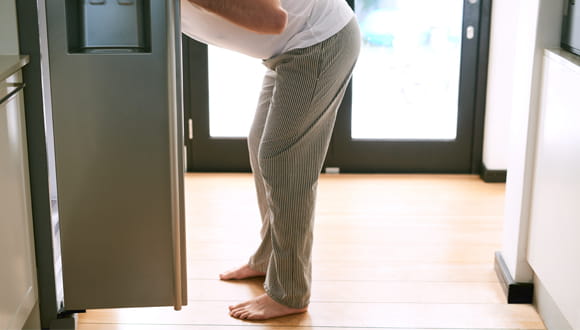Food Safety During a Power Outage: How Long Can Food Last in a Fridge & Freezer Without Power?
June 2, 2021 - Katie McCallumWhen your power goes out, your first thought is likely regarding how bored you're about to be without internet. Your next thought is probably about how hot or cold you're going to be without A/C or heat.
But, once your stomach starts growling, you'll remember that a power outage also means that the perishable foods in your fridge and freezer are officially on the clock.
We all know why we own refrigerators and freezers — cold temperatures are needed to keep many foods safe and fresh. But how long is too long for your perishable foods to be at temperatures higher than usual?
How long can food last in a refrigerator or freezer without power?
To prevent the growth of microorganisms that cause food-borne illness, your refrigerator temperature should be set to less than 40 degrees Fahrenheit and your freezer temperature to 0 degrees Fahrenheit.
Without power, however, these temperatures will inevitably start to climb over time — potentially reaching temperatures that affect the safety of your food.
First thing's first: To help keep your appliances as cool as possible, avoid opening your refrigerator or freezer if your power goes out.
During a power outage, perishable food will stay safe:
- In a refrigerator for up to 4 hours
- In a half-full freezer for 24 hours
- In a full freezer for 48 hours
If power is restored within these respective time frames, your food is likely safe. However, you should still throw out any food that has developed an unusual odor, color or texture.
Importantly, the time frames above apply only if you kept the refrigerator and freezer doors closed. If you opened the doors — especially if you did so more than once — these guidelines are no longer relevant.
Which food items should you throw away after a power outage?
When a power outage lasts longer than four hours, perishable foods in your refrigerator should be thrown out to prevent the chances of developing a food-borne illness.
And — this may go without saying, but we'll say it just in case — never taste food as a way of determining if it's still safe to eat. Instead, know what's perishable and what's not so you can decide what's safe to keep and what needs to be tossed.
Perishable foods in your refrigerator that you should throw out after losing power for more than four hours include:
- Meat, poultry, fish, seafood and soy-based foods (raw or cooked)
- Eggs and egg-based foods
- Cooked or cut vegetables
- Packaged greens
- Cut fruits
- Cooked rice or pasta
- Opened fruit or vegetable juices
- Dairy products, including milk, cream, yogurt, sour cream and soy milk
- Opened baby formula
- Soft cheeses (mozzarella, ricotta, cream, blue, cottage, queso fresca, Monterey Jack, brie and shredded cheese)
- Creamy salad dressings, gravy, cream-filled pastries, custard
- Dough or batter
- Leftovers or packaged foods containing any of the above items
- Mayonnaise, tartar sauce and horseradish (**if above 50 degrees Fahrenheit for more than eight hours)
You should also throw out any food contaminated by juices dripping from raw meat or seafood, as well as any food items that have developed an unusual odor, color or texture.
If a power outage extends through an entire day (if your freezer is only half full) or two days (if your freezer is completely full), it's time to check the food items in your freezer.
Common items found in a freezer that are considered perishable include:
- Any of the above items that you store long-term in your freezer
- Frozen pizzas, TV dinners, or breakfast sandwiches or tacos containing sausage or bacon
- Ice cream
- Custard or cream-based desserts, such as cheesecake
If your freezer maintained a temperature below 40 degrees Fahrenheit, perishable items are safe to eat and/or refreeze. If you don't know the temperature of your freezer, throw away any of the perishable items above that have thawed completely. You can safely refreeze a perishable item that has thawed if, and only if, it still contains ice crystals — the quality and taste of these items may be reduced, however.
Which food items are safe to keep after a power outage?
Just because your fridge or freezer lost power for an extended period of time doesn't mean everything inside of it needs to be tossed for food safety reasons.
For instance, it's safe to keep condiments and food items that have a high acid content, such as:
- Ketchup
- Mustard
- Pickles and relish
- Olives
- Jelly
- Vinegar-based salad dressings
Just keep in mind that these items may spoil sooner than they otherwise would have, so be sure to give these a sniff before using.
Additionally, some foods commonly stored in the refrigerator don't actually require refrigeration (meaning they're still safe to eat), including:
- Whole fruits
- Whole vegetables
- Baked goods (unless they have a cream-based icing, topping or filling)
- Hard cheeses (cheddar, swiss, parmesan, romano)
- Butter and margarine
- Peanut butter
- Herbs
However, if any of these items have developed an odd smell or turned moldy, throw them out.
And if you run into some question marks while cleaning out your fridge and freezer after a power outage, follow this general rule of thumb: When in doubt, throw it out.
Food preservation tips for when you know a power outage might be a possibility
Sometimes, the power goes out without warning and all you can do is avoid opening your refrigerator and freezer and hope the power comes back on before your perishable foods, well, perish.
Other times, such as before a hurricane or winter storm, you know losing power is a possibility.
In these cases, plan ahead to help keep perishable food cold using these tips:
Have plenty of non-perishable foods on hand. This will help ensure that you don't need to open your refrigerator or freezer during the power outage.
Keep a thermometer in both your refrigerator and freezer. Perishable items should remain safe in your refrigerator for four hours, in a half-full freezer for 24 hours and in a full freezer for 48 hours, but these guidelines are estimates. Moreover, they become less trustworthy if you open your fridge or freezer. The most accurate way of knowing if your food is safe after a power outage is to use an appliance thermometer as your guide.
Fill up your freezer. A full freezer can hold a safe temperature twice as long as one that's only half full. Consider filling empty space in your freezer with perishable items from your refrigerator, which will also help extend the length of time these foods remain safe, as compared to being in a refrigerator without power. You can also fill your freezer with jugs of water or bags of ice.
Have a cooler and plenty of ice ready. If the power doesn't come back on after four hours, move perishable items in your refrigerator to an insulated cooler packed with plenty of ice. Use a thermometer to ensure the cooler stays below 40 degree Fahrenheit and add ice as needed.










